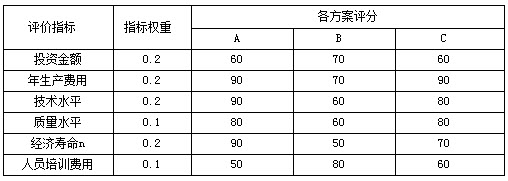某技术改造项目拟引进国外设备,据调研,同类项目通常投资额为3000万元(人民币),年生产费用通常水平应为1200万元,基准收益率为10%,技术水平、质量水平可按一般水平为通常水平,现有三个方案可供选择:
A方案:引进设备(1)总费用为4000万元(人民币),年生产费用900万元(人民币),技术水平先进,质量水平高,经济寿命15年,人员培训费用高。
B方案;引进设备(Ⅱ)(FOB)价格为200万美元(1:8.3),重量500t,国际运费标准为400美元/t,海上运输保险费率为0.25%,银行财务费为0.5%,外贸手续费为1.5%,关税税率为20%,增值税税率为17%,车辆运杂费为2.5%,国内其他费用为394.129万元(人民币)。
年生产费用1200万元(人民币),技术水平、质量水平一般,经济寿命期10年,人员培训费用较低。
C方案:引进设备(Ⅲ)总费用2500万元(人民币),年生产费用1000万元(人民币),技术水平较先进,质量水平较高,经济寿命期12年,人员培训费一般。
各方案综合评分如表6-5所示。
表6-5 各方案综合评分表

1.计算B方案引进设备(Ⅱ)的总费用。
2.按照评分标准,给A、B、C三方案评分。
3.计算各方案的综合得分,做出方案选择。
4.根据最小费用原理,考虑资金时间价值,做出方案选择。
参考答案:
1.B方案引进设备费用计算:
确定引进设备货价=200×8.3=1660(万元)
国际运费=400×500×8.3×10-4=166(万元)
国外运输保险费=(1660+166)×0.25%=4.565(万元)
进口关税=(1660+166+4.565)×20%=366.113(万元)
增值税=(1660+166+4.565+366.113)×17%=373.435(万元)
外贸手续费=(1660+166+4.565)×1.5%=27.458(万元)
银行财务费率=1660×0.5%=8.3(万元)
进口设备原价=1660+166+4.565+366.113+373.435+27.458+8.3=2605.871(万元)
总价=394.129+2605.871=3000(万元)
2.按照评分标准,给A、B、C三方案评分(见表6-13)。
表6-13 各方案综合评分表

3.分别计算各方案综合得分:
A方案得分=60×0.2+90×0.2+90×0.2+80×0.1+90×0.2+50×0.1=79(分)
B方案得分=70×0.2+70×0.2+60×0.2+60×0.1+50×0.2+80×0.1=64(分)
C方案得分=60×0.2+90×0.2+80×0.2+80×0.1+70×0.2+60×0.1=74(分)
由计算结果可知,A方案综合得分最高,因此应选择引进国外成套设备。
4.由于各方案经济寿命期不等,考虑资金的时间价值,选取费用年值AC为评标指标。
A方案费用年值:
ACA=4000 (A/P,10%,15)+900=4000×
 +900
+900
=1425.90(万元)
B方案费用年值:
ACB=3000 (A/P,10%,10)+1200=3000×
 +1200
+1200
=1688.24(万元)
C方案费用年值:
ACC=2500 (A/P,10%,12)+1000-2500×
 +1000
+1000
=1513.67(万元)
由计算结果可知,A方案的费用年值最低,因此应选择引进国外成套设备。
